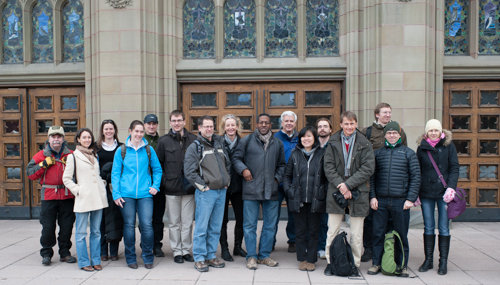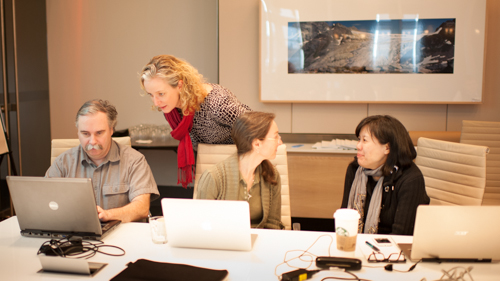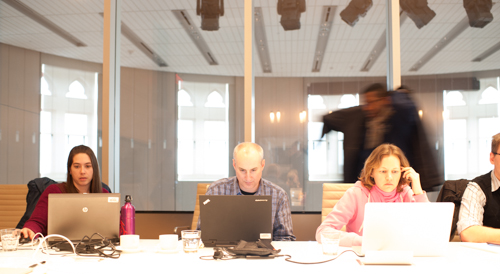Report: Collaborators meet to discuss the future of Specify

Joanna McCaffrey, iDigBio Biodiversity Informatics Manager, was invited by the Specify collections management software team to attend a future feature planning meeting in Ottawa the week of March 5th, 2013. The meeting was hosted by James Mackin (recently from Harvard) of Agriculture Canada at the Canadian Museum of Nature. Also in attendance were Jim Beach, Rod Spears, Ben Anhalt (Specify), Paul Morris, Maureen Kelly (Harvard and FilteredPush), Kessy Abarenkov (PlutoF developer from the Estonian DINA project), Chris Lewis, Heather Cole, Christine Lowe, Satpal Bilkhu (Agriculture Canada), and the team from the NRM Stockholm DINA project: Fredrik Ronquist, Karin Karlsson, Markus Skyttner, Ida Li, Kevin Holston, Ingimar Erlingsson, Markus Englund (virtually), Johan Dunfalk (virtually) and Mickael Graf (virtually).

First Day:
James Mackin and Jim Beach welcomed the conferees on the first morning. We all introduced ourselves and described what we wanted to contribute to the meeting. Jim Beach set the meeting objectives, the schedule for the next three days, and discussed outcome priorities. Fred Ronquist, Jim Beach and Paul Morris followed up with ideas, scope, and challenges for the collaboration ahead. The meeting's purpose was to design a roadmap for collaboration between the DINA NRM team from Stockholm (led by Fred Ronquist), the Specify team from Kansas, the FilteredPush team from Harvard, and Agriculture Canada; the Estonian DINA project team will also be collaborating. Prior to the conference, Joanna McCaffrey had prepared a list of key usability features that would improve the digitization experience of Specify users, with the hope that these would also be incorporated into the work ahead.
Some critical items from her list:
- fully seamless support for process-driven, best practice digitization workflows
- highly adaptive and customizable output (e.g., labels, reports, journals, loan forms)
- ease of export (Joanna M. suggested an 'export to iDigBio' button)
- ease of product updates
- cloud computing for small collections
- fully functioning web interface for the management of collections data
- expert knowledge of image handling workflow, including naming, storage, file formats, metadata, archiving and processing
In the afternoon, the KU team (Specify) presented their upcoming 'thick client' software product, a roadmap and product overview for current development, other web products, and 'thin client' products. Included in their priorities are data exchange with Symbiota, messaging, and hosting aggregated databases. Work began as a team to define an itemized priority list of requirements for modules.

Second Day:
The morning was devoted to demonstrations:
To begin, Fred Ronquist introduced the NRM team and explained their funding status. He demonstrated the DINA barcode portal, web search, inventory client and taxon pages system. This was followed up by open discussion. NRM is interested in building on the Specify code base, and it is everyone's hope that one outcome of the meeting will be a joint work plan that includes everyone's proposed product features.
Other demos included:
- Specify web application and considerations for technology improvements
- Specify web portal, technology components and design decisions
- Specify thick client new capabilities, images and GUIDS
- FilteredPush
- SeqDB, and Specify changes to DINA data
After the coffee break, a management discussion of the proposed development relationship included business topics such as funding and project management as well as project-specific topics such as the taxon tree implementation that DINA has developed in Estonia. Other areas of discussion included RESTful API specification, the future of JPA as a Specify backend, Postgres vs. MarieDB, and the mobile applications for the iPad version of Specify.
In the afternoon, communication focused more on the management of the work ahead, including collaboration planning, scope, methods, and self-interests: the 'who does what' discussion.
- Priorities: how to identify, manage, track, and complete a loosely-coupled software development federation
- Administration: communication methods, development methods, technical standards, and - importantly! - the name of the new consortium (TBD)
- Consortium institutional committments: an MOU or a longer-term, internationally affiliated non-profit? This is something to be worked out
- Formalization of a DINA-Specify consortium and long-term issues related to funding and support for users
We covered these very interesting areas with candor and collegiality.

Third Day:
The last morning was spent synthesizing the future requirements and development objectives with the collaboration roadmap. Karin Karlsson and Jim Beach, representing their respective teams, will be co-project managers. They will meet virtually on a weekly or bi-weekly basis and will share a github node.
In the afternoon, we toured the AgFood Canada location on the other side of town. As part of this, we stopped in the collections area to support Jim Beach and Rod Spears in their Specify talk to the collections staff.
Jim Beach and Karin Karlsson will produce an executive summary of this meeting.







